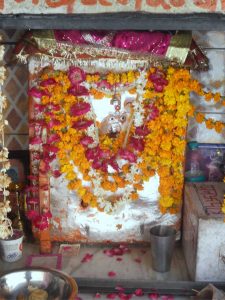Lord Bhairava


Bhairava (Sanskrit: भैरव, “Terrible” or “Frightful” ,[1]), sometimes known as Bhairo or Bhairon or Bhairadya, is the fierce manifestation of Shiva associated with annihilation.[2] He is one of the most important deities of Nepal, sacred to Hindus alike.
He is depicted ornamented with a range of twisted serpents, which serve as earrings, bracelets, anklets, and sacred thread (yajnopavita). He wears a tiger skin and a ritual apron composed of human bones.[3] Bhairava has a dog as his divine vahana (vehicle).
Bhairava himself has eight manifestations: Kala Bhairava, Asitanga Bhairava, Samhara Bhairava, Ruru Bhairava, Krodha Bhairava, Kapala Bhairava, Rudra Bhirava, and Unmatta Bhairava. Kala Bhairava is conceptualized as the Guru of the planetary deity Saturn. Bhairava is known as Vairavar in Tamil where he is often presented as a Grama Devata or folk deity who safeguards the devotee on all eight directions (ettu tikku). Known in Sinhalese as Bahirawa, he protects treasures. Lord Bhairava is the main deity worshipped by the cannibalistic Aghora sect.
see Wikipedia, the free encyclopedia FOR FURTHER DETAILS.
One of the most famous temples in Ujjain, this temple adds to the similarity of Ujjain and Kashi. As at Kashi, Kal Bhairav is the Kshetrapal, or the guardian deity of the city, and it is the custom to leave the keys with the deity when the temple is closed at night, in the belief that he takes care of the temple and its properties. However, this temple is famous, not for its origins or its importance in the scheme of temples, but for its deity who guzzles wine by the gallons. Yes, the main offering to the deity is wine, and this is also the only Prasad given to the devotees. People flock to this temple, all carrying bottles of wine as an offering. Liquor is available 365 days a year outside the temple.
Lord Bhairav is considered to be the incarnation (Avatar) of Lord Shiva. In the contemporary times, Bhairon has been worshipped by millions of people to get the powerful blessings from the god. Bhairav is a fierce form of Shiva. It is believed that Bhairon is connected to the Southern face and relates to the Mahavidya goddess named Bhairavi who gives Lagna shuddhi (purification of the Disciple). This purifies and protects the body, self-concept, personality, and other attributes associated with the Disciple.
Bhairon- Lord of Rahu Bhairav or Bhairavi are worshipped when there are malefic planets in the birth lagna (time) or when natural malefic planets are transiting. Bhairon removes and protects a person from these types of effects. As per the Indian astrology, Rahu is known as a shadow planet, which plays an important role in the life of a creature. The Indian astrologers often suggest people, the worship of Lord Bhairav to reduce the evils caused by the malefic position of Rahu in the horoscope.
Bhairon – The Lord of Yogis Lord Bhairav is worshipped by Yogis and Tantriks to gain Siddhis. Bhairon is regarded as the guardian of Yogis and Tantriks who attain accomplishment of Mantras by doing Sadhana (devotion).
Bhairon – The Kotwal Lord Bhairav guards the temple of Lord Shiva and due to this fact, he is also known as “kotwal” (Guard).
Bhairav – The Worship Worship of Lord Bhairon is very useful to win over your enemies, success and all materialistic comforts. It is very easy to please lord Bhairav by doing normal worship daily. Coconut, Flowers, Sindoor, Mustard oil, black til etc are offered to the God and the following mantra is chanted with devotion to get God’s Blessings.
Main (Mula) Mantra: “OM BATUK BHAIRVAYE NAMHA”
Favorite flower and color of Bhaivara is Arali (red in color), Red Rose can be also used.
The correct sequence of prayer to Lord Siva is as follows:
- Ganeshji
- Nandi (Bull)
- Lord Siva
- Goddess Parvati
- Lord Bhaivara
NOTE: care must be taken when praying to the holy Lingam (Lord Siva). the view of Nandi (Bull) towards the holy Lingam (Lord Siva)should NOT be blocked.
